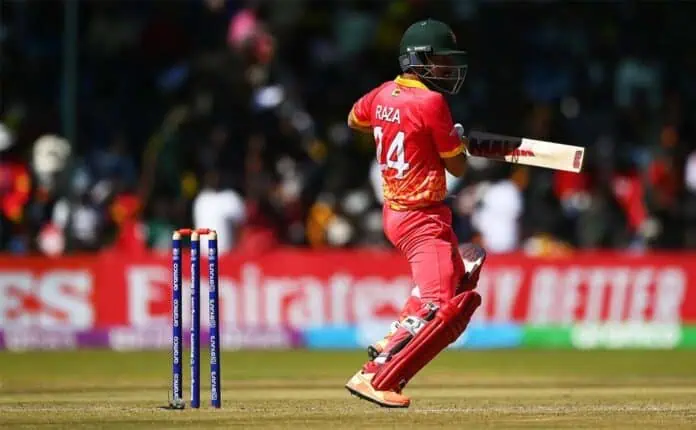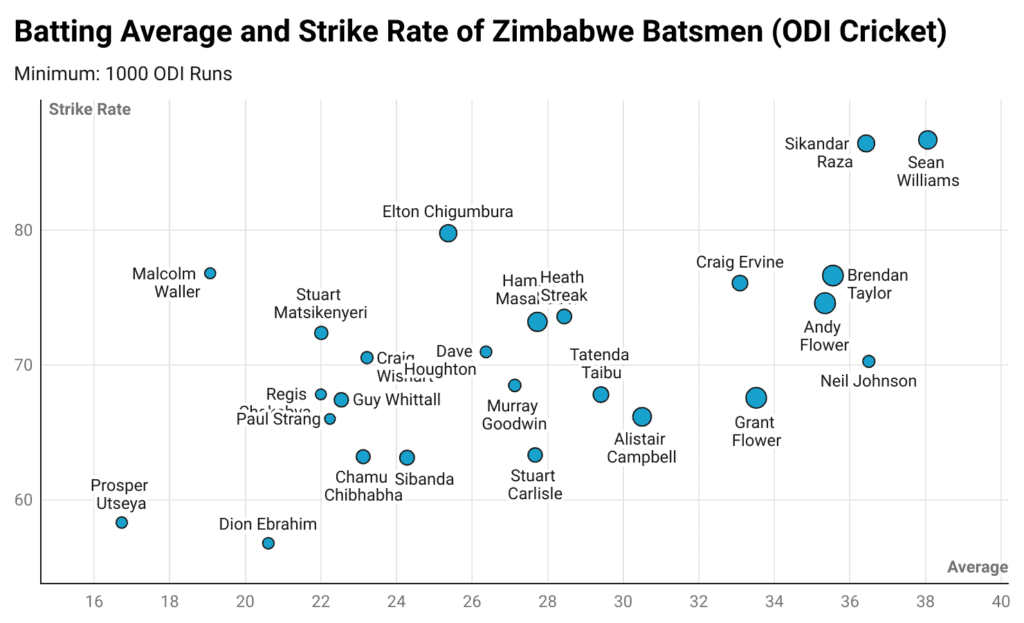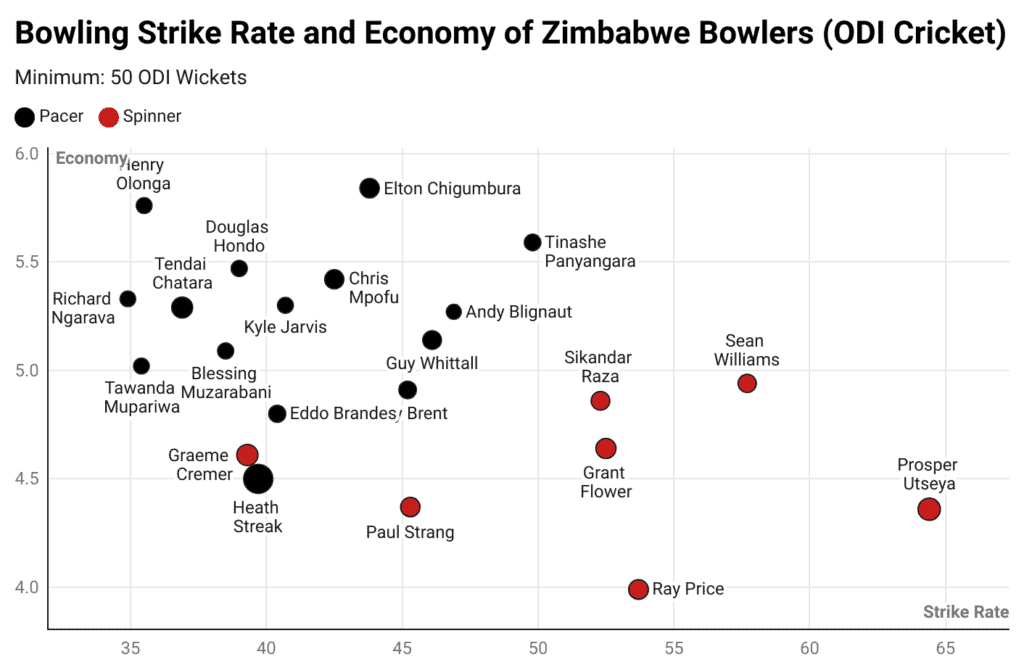Associate nations in cricket function as the underdogs that all neutrals love to support, yet ICC hasn’t been kind to them in recent years. Although the decision to minimise the number of teams in CWC was taken from the point-of-view of financial profits, the absence of such nations means fewer opportunities for the sport to grow. CWC 23 participants; Bangladesh, Sri Lanka and Afghanistan are evidence of how competition from premier sides is necessary for novice nations to progress, whereas the sole associate squad, The Netherlands, exhibited the thrill and climax such teams bring to the international stage. Well, Zimbabwe is one of the original sides that captured the very essence of such associate nations.
Battling it out in the South African domestic circuit under the name of Rhodesia, Zimbabwe gained ICC membership after their independence in 1980 and, in their first-ever ODI, secured the biggest upset of the format at the time by defeating Australia. Unfortunately, the team couldn’t build around this victory, with the gap between their 1st and 2nd wins being 3,205 days. However, a golden generation in the late ’90s saw the Chevrons on the rise, with a 5th-place finish in the 99 World Cup being the demonstration of their potential.
The 03′ edition in the African continent was supposed to be the next step in their progression, but rather, it turned out to be the start of a steep decline due to the surrounding political unrest. A decline that saw their test status getting revoked, a suspension from international cricket and consecutive failures in reaching the ultimate tournament. However, qualification for 2027 WC is sealed through host status, and with that note.
Here’s our All-time Zimbabwe ODI XI, hoping Zimbabwe has its redemption and completes the story left unfinished in 2003.
Alistair Campbell (C)
A child prodigy whose legacy within African cricket lies majorly around his administration achievements; although Campbell wasn’t able to achieve the career arc that was projected when he debuted as a 19-year-old in the World Cup, his rugged approach, along with leadership achievements, make him our captain for today’s article.
- Matches: 188
- Runs: 5,185
- Average: 30.50 (34.78 as opener)
- Strike Rate: 66.18
Averaging 16 after his first 15 innings, a 131(115)* against Sri Lanka got his career moving. A hard-hitting batsman whose intent couldn’t transpire into a high strike rate, Campbell was inconsistent with the willow. For example, he scored 2 centuries against the Australian side of the late ’90s, yet his average against them was a paltry 24.93. Another fact regarding his hundreds was that 5 out of his total 7 centuries came in losing causes.
He also captained Zimbabwe in 86 ODIs, with a W/L ratio only behind Craig Ervine. More importantly, he overlooked the team’s best years, including the 1999 World Cup, when they missed a semi-final spot only on the basis of net run rate.
Neil Johnson
It might baffle our readers that a player with an ODI career spanning just 3 years is occupying the second opening spot, but considering that Neil Johnson was amongst the best all-rounders in that period, along with his superior performances with the bat in the 1999 World Cup, we chose him as the partner to skipper Campbell.
- Matches: 48
- Runs: 1679
- Average: 36.5
- Strike Rate: 70.28
- Wickets: 35
- Bowl Average: 34.86
- Economy: 4.87
Opening the batting and bowling (simultaneously) 25 times out of these 48 games gives us a glimpse of Neil’s importance in Zimbabwe’s most prolific period. Equally proficient against spinners and pacers, Johnson brought his A-game against the top competitors. His batting average against Pakistan, South Africa, and Australia stands at 50.83, 47, and 83, respectively, across 15 combined contests.
Ultimately, the foremost display of his ability was seen in the 99 CWC. The 6th highest scorer with a batting average of 52.43 along with 12 wickets, which he picked @19.42, Neil’s average difference of 33.01 is the 7th best in World Cup history.
Brendan Taylor
Making his international debut at the age of 18 amidst the backdrop of the “Death of Democracy” protest, Taylor’s career is mostly seen as one that was always surrounded by unfortunate circumstances. Yet, he managed to make the most of the limited opportunities presented to his country during his 18-year stay.
- Matches: 203
- Runs: 6,684
- Average: 35.55 (43.37 at 3)
- Strike Rate: 76.65 (82.11 at 3)
To give context as to how much dependent the Zimbabwean side was on him,
The ratio of Taylor’s batting average to Zimbabwe’s top 7 in the 203 matches he played in is 1.33. For reference, Kohli’s measure under this filter is 1.35.
Amongst the few 21st-century Chevron batters who were comfortable against quality spin, he was clever in his approach against the pacers, using the uppercut to great effect.
He underperformed in his first two World Cups but made up for it in his third edition, where he was the fourth-highest run scorer with an average of 72.17 and a scoring rate of 106.91.
Andy Flower (WK)
The highest-run accumulator for his nation, the elder of the Flower brothers was often viewed as the sole world-class player of his side. Although this notion was established largely due to his performances in the whites, Andy Flower still remains one of the best to wear the red and gold.
- Matches: 213
- Runs: 6786
- Average: 35.34
- Strike Rate: 74.59 (81.51 at 4)
- Dismissals: 165
Announcing himself with a century in his debut, Flower would reach the 3 figure mark only 3 more times in his 12-year career. His conversion rate of 6.78 is the 7th lowest for batters with a minimum of 4K runs. He wasn’t the pioneer of the reverse sweep, but very few batsmen have used it as efficiently as Andy did against the spinners, which is evident in the averages of 40.56 and 38.29 against India and Sri Lanka, respectively.
Forced to retire after his armband protest in the 03′ World Cup, he ended his journey on a high, scoring 332 runs @47.43 in the tournament. Considering he also has the most dismissals in addition to his test experience, Andy will also do the gloves in this XI.
Grant Flower
The most capped ODI player in the country, Grant slid across the batting order throughout the 18 years that separated his first and last match. Although he played 62% of his matches at the top, his best performances came lower down the order, and thus, he would accompany his sibling in the middle overs.
- Matches: 221
- Runs: 6,571
- Average: 33.52 (37.65 at 5)
- Strike Rate: 67.58 (74.81 at 5)
- Wickets: 104
- Bowl Average: 40.63
Grant played the role of an anchor during his earlier years but got to showcase his strokeplay later on when he hovered around the number 5 position. Inheriting some of his elder brother’s most beautiful cross-batted shots, he was the first batsman to carry his bat in an ODI game, scoring 84* out of the team’s total of 205 against England in 1994.
Apparently, Grant wasn’t a stranger to waging a lone fight against the opposition, as evidenced by the fact that three out of his six centuries came when his team’s scorecard read 41/6, 39/3, and 7/2.
Sean Williams
In his three-decade journey, which saw him start as a temperamental teenager during his debut and become one of the team’s elder statesmen during retirement, Sean was a multi-talented athlete whose varied skills made his role similar to that of our next two players.
- Matches: 156
- Runs: 4,986
- Average: 38.06 (42.61 at 6)
- Strike Rate: 86.69
- Wickets: 83
Oscillating between positions 3-6 consistently in his stint, Sean was equally successful in fulfilling all of his responsibilities and will play as one of the finishers in our XI. Part of 3 World Cups on 3 continents, Sean has both the highest average (54.66) as well as the highest strike rate (101.23) for a Zimbabwean batter in the grand stage (min. 125 runs).
Although his performances against top sides are not flattering, his batting average went below 30 in only three of the 13 countries he played in. Sean complimented his batting strokes with useful slow-left arm loopers and retained his ability to adapt in the fielding department, upholding the high standards the country has set over the years.
His most prolific year was his final one in 2023, when he scored 720 runs @ 90 with a strike rate of 129.26. This included a 100-average 2023 ICC qualifier campaign, for which he secured the man-of-the-series award. However, Zimbabwe fell short of finals qualification.
Sikander Raza
The first non-retired player on this list, Raza, has become one of the faces of the current push for greater associate participation in ICC tournaments through his T20 miracles, though he has also pulled his weight in the ODIs during this same period.
- Matches: 142
- Runs: 4,154
- Average: 36.44 (43.37 at 7)
- Strike Rate: 86.43 (95.85 at 7)
- Wickets: 88
Making his debut in 2013, Raza struggled to deliver persistent production and like fellow teammate Sean, proved to be a crucial asset to the team through contributions in multiple departments. Although his bowling isn’t as effective as that of his in the shortest format, given his ODI bowling average is above 40, he is the 2nd-highest wicket-taker of the side since his debut and has a knack for snapping big partnerships. 43.32% of his wickets have been of top-order (1-3) batsmen.
Meanwhile, his batting figures have gone up a notch in the related years. Since 2020, he has scored 1,498 runs @ 41.61 with a strike rate of 96.21. However, his best performance came in the earlier half of his career when he won the man-of-the-series award in the 2018 ICC qualifiers.
Heath Streak
The highest wicket-taker for the men in maroon in both formats; the gap between him and the 2nd highest in ODIs is of 102 dismissals. Recently succumbing to his liver cancer at the age of 49, Heath Streak’s impact on the Zimbabwean bowling lineup was arguably more than the influence of any of the above-mentioned batters had on the respective batting department.
- Matches: 189
- Wickets: 239
- Bowl Average: 29.82
- Economy: 4.51
- Runs: 2,943
- Bat Average: 28.3
- Strike Rate: 74.3
A much more agile sportsman than his build suggested, Heath accounted for 23.3% of his teams’ wickets across all the ODIs he played in during his 13-year span, and he did this with an average of 29.82 which may not seem special, but given the fact that his team as a whole had a bowling mean of 39.3, one develops greater admiration for Streak’s figures.
Preferring to hit the deck hard, which went well with his ability to generate awkward bounce, Streak had disappointing campaigns in ICC tournaments with the bowl, but his 31.38 batting average in those games covered those mishaps to an extent. In fact, his batting performances are grossly overlooked. Heath possessed a batting average above 30 against opponents such as Australia, South Africa and the West Indies.
Moreover, he got better with the wood as the years progressed, averaging 37.52 with the bat in his last 5 years and was doing fine with the ball too, aggregating 28.07. If not for his premature retirement at the age of 31 due to board politics, the African Beefy might have penned more glorious chapters for his land.
Paul Strang
An orthodox leggie in his methods, Paul Strang was also a typical wrist spinner when it came to inconsistent showings, yet his highs in 96′ and 99′ meant he is the only bowler in today’s lineup with less than 100 career wickets.
- Matches: 95
- Wickets: 96
- Average: 33.05
- Economy: 4.37
- Strike Rate: 45.3
A testament to the comment of him being irregular in his performances is the fact that despite having an average under his career figure of 33.05 against 4 out of the 8 test nations he faced, he gave runs at a rate of more than 50 per dismissal against the remaining 4 opponents. Having the ability to turn a match with his inspiring long spells, all 6 of his MOTMs came in winning causes, and his average of 17.53 in wins is the best amongst his countrymen (min. 15 wins).
Strang picked up 15 wickets across two consecutive World Cups, with him possessing the second-best average (16.00) in the 96 edition. Apart from his bowling, Strang added around 1000 runs @ @22.24 in his 8-year career. Amusingly, he was tried out in all 11 positions except number 6.
Graeme Cremer
The 2nd leg spinner of the eleven, Cremer had tough competition from slow left-armer Raymond, but the former’s final push in his later years saw him through in this debate.
- Matches: 96
- Wickets: 119
- Average: 30.22
- Economy: 4.61
- Strike Rate: 39.3
Yet another teenage debutant of the country, Cremer’s career average of 30.22 is the 3rd best amongst Zimbabwean bowlers with at least 50 wickets, and this is despite him playing the majority of his career in the 2010s. Moreover, his average in games held outside of Zimbabwe (27.48) is the best for any bowler from the province. In fact, all of the other top-10 wicket-takers have a bowling mean in excess of 30.
Announcing his retirement in 2012, he made a comeback in 2015 and had his best time in his final two years, when he picked 43 scalps @ 24.65, including the 2018 qualifiers, where he performed with similar figures (22.0).
Tendai Chatara
Zimbabwe has produced fiery speedsters right from their inclusion in the 80s, and the tradition has continued, given the current band of promising pacers. Yet, Chatara’s gentle yet clever approach overshadows them for the time being.
- Matches: 87
- Wickets: 115
- Average: 32.62
- Economy: 5.29
- Strike Rate: 36.9
In accordance with his bowling procedure, Chatara may not have had singular performances that one could recollect at the mention of his name, but he has provided security to the team in his 10-year career, which will most likely terminate at the 2027 home CWC.
Primarily operating as a strike bowler, only Olonga and Mupariwa have better career strike rates than him. He has had a tough time against Australia and India, though he has done well against teams such as Pakistan, South Africa and Sri Lanka, averaging below the 30-run mark against each of them.
Players Who Missed Out
We start by mentioning Zimbabwean sporting legend Dave Houghton. One of the state’s earliest cricket talismans, his premier format was Tests, where he averaged 43.0 compared to his ODI average of 26.4. Given that he was competing for the already stacked middle-order spots, we had to keep him out.
Considering we went with a batting-heavy side, quite a few bowlers missed out on an opportunity, and the best of the lot was Ray Price. With an economy of 3.99 and a stellar 2011 CWC, his standings in other aspects, namely, performance against top sides and away from home, were not up to the mark, and since we already picked 2 spinners, we gave Chatara the nod over him.
Tendai’s spot was the toughest to finalise, with Eddo Brandes emerging as the leading challenger. But the latter’s injury-riddled career, along with the fact that he actually didn’t have a great showing on the grand stage except for his England heroics, meant we went ahead with his younger counterpart.
Zimbabwe All Time ODI XI is
- Alistair Campbell (c)
- Neil Johnson
- Brendan Taylor
- Andy Flower (wk)
- Grant Flower
- Sean Williams
- Sikander Raza
- Heath Steak
- Paul Strang
- Graeme Creamer
- Tendai Chatara
12th Man: Dave Houghton
Extras: Ray Price, Eddo Brandes



